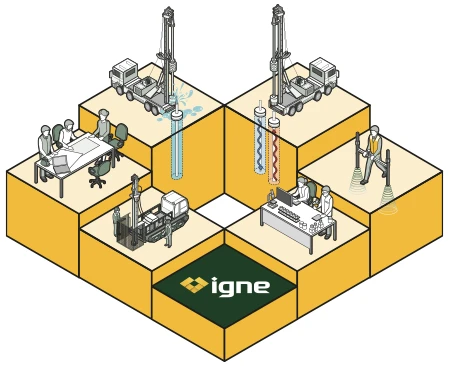

Precise Levelling Monitoring Surveys
Precise levelling is a high-accuracy surveying technique used to monitor the subtle vertical movements of buildings, structures, or the ground over time.
About
What are Precise Levelling Monitoring Surveys?
Precise levelling plays a key role in monitoring surveys, especially in projects where even minor shifts can have major implications for safety, stability, and long-term performance.
In construction and infrastructure development, precise levelling is vital for tracking changes in ground levels and for detecting settlement, subsidence, or uplift of structures. The technique involves measuring vertical distances with millimetric accuracy, using specialised equipment to ensure that results are reliable and precise.
This method is typically employed in long-term monitoring projects, where ongoing assessment of the structure or ground’s behaviour is crucial to mitigate risks and ensure stability.

Useage
Why Carry Out Precise Levelling?
The importance of precise levelling in monitoring surveys cannot be overstated. Even minor changes in ground levels can lead to significant structural damage, costly repairs, or, in extreme cases, project failure.
Conducting precise levelling allows project managers and engineers to catch these subtle movements early, preventing potential issues from escalating.
In sectors like infrastructure, residential development, and industrial projects, precise levelling is used to ensure the longevity and safety of structures. If your project involves heavy construction, excavation, or ground disturbance, precise levelling provides peace of mind that the structure will not experience unforeseen shifts or damage.
It is particularly useful in areas prone to ground subsidence or where construction is taking place near existing structures, where slight changes in level can compromise safety.
Trust
Why Trust Igne for Precise Levelling Monitoring Surveys?
At Igne, we are experts in all aspects of site investigation, geotechnical analysis, and materials testing, both on-site and in the lab. Our team is highly experienced in carrying out precise levelling surveys across various sectors, including property, infrastructure, and construction.
We have worked on projects of all sizes, from single-phase developments to large, complex, multiphase projects.
We pride ourselves on our ability to de-risk projects by providing thorough, detailed insights into ground conditions and environmental factors. Our team employs the latest technology and techniques to ensure millimetric accuracy in all levelling surveys, providing you with the data needed to make informed decisions and safeguard your project.
Igne’s precise levelling surveys help to avoid costly delays, unnecessary risks, and potential liabilities associated with poorly monitored ground and structural movements.
Risks
The Risks of Not Conducting Precise Levelling
Failing to carry out precise levelling on your site can lead to a range of risks, many of which can have serious financial, safety, and operational implications. Without accurate and ongoing monitoring, you may miss early warning signs of ground movement or structural settlement, which can compromise the integrity of buildings or infrastructure.
The consequences of not performing precise levelling may include:
- Structural instability, potentially leading to failure or collapse
- Increased maintenance and repair costs due to undetected damage
- Delays in project timelines caused by unforeseen ground issues
- Reduced safety for workers and residents due to undetected risks
- Legal and financial liabilities if structures are deemed unsafe
In areas prone to subsidence, seismic activity, or heavy construction loads, the lack of precise monitoring can result in long-term complications that are far more costly to resolve than they would have been to prevent with regular precise levelling surveys.
Benefits
The Benefits of Precise Levelling
Precise levelling offers many benefits beyond risk management. Its primary function is to provide accurate, real-time data on vertical movements, but it also supports project efficiency and long-term success.
Some key benefits include
Increased Structural Stability
Precise levelling ensures that any small shifts are identified and addressed early, maintaining the safety and integrity of the structure.
Optimised Project Timelines
By tracking ground and structural movements over time, project managers can make informed decisions, avoiding costly delays caused by unanticipated subsidence or uplift.
Enhanced Safety
Regular monitoring reduces the risk of accidents, ensuring that construction workers and site visitors are operating in a safe environment.
Cost Savings
Early detection of issues reduces the likelihood of expensive repairs or emergency interventions, as well as potential legal liabilities.
Peace of Mind
With reliable data, stakeholders can be confident that their project is being carefully monitored, reducing uncertainty and providing a clear path forward.
Process
How Precise Levelling is Done
Precise levelling is a specialised process that requires accurate equipment and trained professionals to ensure data reliability. The method typically involves:
-
Setting Up Control Points
Permanent benchmarks are established around the site to serve as fixed reference points. -
Using High-Accuracy Equipment
Precision levels or digital levelling instruments are used to take measurements, which can detect vertical changes down to fractions of a millimetre. -
Regular Monitoring
Levelling is carried out at scheduled intervals throughout the project’s lifecycle to track any changes in elevation. -
Data Analysis
The data collected is analysed to determine trends, detect movements, and predict potential issues. -
Reporting
Clear, detailed reports are provided to project managers and engineers to help guide decisions about project safety and progress.
Learn More
Frequently Asked Questions about Precise Levelling Surveys
- What is precise levelling used for?
To monitor small vertical movements of the ground or structures. It helps identify issues like settlement, subsidence, or uplift to maintain safety and stability.
- How accurate is precise levelling?
It can detect changes in elevation that are less than a 1mm, making it one of the most accurate methods for tracking ground and structural movements.
- What equipment is used in precise levelling?
High-accuracy levelling instruments such as digital levels or precision levelling tools are used to measure changes in elevation. These instruments can detect very small vertical shifts with a high degree of reliability.
- Why is precise levelling important in construction?
Precise levelling ensures that the ground and structures are stable and safe. It helps detect issues early, preventing expensive repairs or structural failure.
- How often should precise levelling be carried out?
The frequency of precise levelling depends on the project. In some cases, it may be carried out monthly, while in others, annual checks are sufficient. It depends on the level of risk and the specific site conditions.
The Next Step
For more information about our precise levelling and monitoring surveys, explore the full range of services we offer.
Contact Igne today to discuss your project’s requirements and see how we can help ensure its success.
